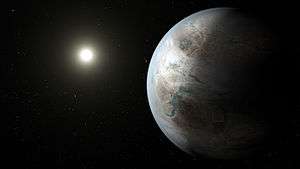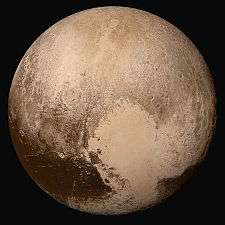2015 YA
| Discovery | |
|---|---|
| Discovered by | Catalina Sky Survey |
| Discovery date | December 16, 2015 |
| Designations | |
| MPC designation | 2015 YA |
|
Aten asteroid,[1][2] Earth crosser | |
| Orbital characteristics[2][3][4] | |
| Epoch January 13, 2016 (JD 2457400.5) | |
| Uncertainty parameter 6 | |
| Observation arc | 5 days |
| Aphelion | 1.27598 AU |
| Perihelion | 0.71908 AU |
| 0.99753 AU | |
| Eccentricity | 0.2791 |
| 0.99632 y (363.91 d) | |
| 99.79° | |
| Inclination | 1.6249° |
| 255.3291° | |
| 83.849° | |
| Earth MOID | 0.00356 AU |
| Physical characteristics | |
| Dimensions | 9–22 m[a][5] |
| 27.4[2] | |
|
| |
2015 YA (also written 2015 YA) is an Aten asteroid that is a temporary horseshoe companion to the Earth, the eleventh known Earth horseshoe librator.[6] Prior to a close encounter with the Earth on 2015 December 15 2015 YA was an Apollo asteroid.
Discovery
2015 YA was discovered on 2015 December 16 G. J. Leonard and R. G. Matheny observing for the Catalina Sky Survey.[7] As of 9 March 2016, it has been observed 47 times with an observation arc of 5 days.[2]
Orbit and orbital evolution
2015 YA is currently an Aten asteroid (Earth-crossing but with a period less than a year). Its semi-major axis (currently 0.99753 AU) is similar to that of Earth (1.00074 AU), but it has a moderate eccentricity (0.2791) and very low orbital inclination (1.6249°). It alternates between being an Aten asteroid and being an Apollo asteroid, although its orbital evolution is rather chaotic. As of 9 March 2016, this object is the 16th known Earth co-orbital and the 11th known object following a horseshoe path with respect to our planet. Asteroid 2015 YA follows an asymmetrical horseshoe path with respect to our planet; the value of its relative mean longitude oscillates about 180°, but enclosing 0°.[6]
Physical properties
With an absolute magnitude of 27.4 mag, it has a diameter in the range 9–22 meters (for an assumed albedo range of 0.04–0.20, respectively).
See also
Notes
- ^ This is assuming an albedo of 0.20–0.04.
References
- ↑ List Of Aten Minor Planets
- 1 2 3 4 2015 YA at the JPL Small-Body Database
- Discovery · Orbit diagram · Orbital elements · Physical parameters Retrieved 2016-03-09
- ↑ AstDys-2 on 2015 YA Retrieved 2016-03-09
- ↑ NEODyS-2 on 2015 YA Retrieved 2016-03-09
- ↑ Absolute-magnitude conversion table (H)
- 1 2 de la Fuente Marcos, Carlos; de la Fuente Marcos, Raúl (1 April 2016). "A trio of horseshoes: past, present and future dynamical evolution of Earth co-orbital asteroids 2015 XX169, 2015 YA and 2015 YQ1". Astrophysics and Space Science. 361 (4): 121 (13 pages). arXiv:1603.02415
 . Bibcode:2016Ap&SS.361..121D. doi:10.1007/s10509-016-2711-6.
. Bibcode:2016Ap&SS.361..121D. doi:10.1007/s10509-016-2711-6. - ↑ Discovery MPEC
- Further reading
- Understanding the Distribution of Near-Earth Asteroids Bottke, W. F., Jedicke, R., Morbidelli, A., Petit, J.-M., Gladman, B. 2000, Science, Vol. 288, Issue 5474, pp. 2190–2194.
- A Numerical Survey of Transient Co-orbitals of the Terrestrial Planets Christou, A. A. 2000, Icarus, Vol. 144, Issue 1, pp. 1–20.
- Debiased Orbital and Absolute Magnitude Distribution of the Near-Earth Objects Bottke, W. F., Morbidelli, A., Jedicke, R., Petit, J.-M., Levison, H. F., Michel, P., Metcalfe, T. S. 2002, Icarus, Vol. 156, Issue 2, pp. 399–433.
- Transient co-orbital asteroids Brasser, R., Innanen, K. A., Connors, M., Veillet, C., Wiegert, P., Mikkola, S., Chodas, P. W. 2004, Icarus, Vol. 171, Issue 1, pp. 102–109.
- A trio of horseshoes: past, present and future dynamical evolution of Earth co-orbital asteroids 2015 XX169, 2015 YA and 2015 YQ1 de la Fuente Marcos, C., de la Fuente Marcos, R. 2016, Astrophysics and Space Science, Vol. 361, Issue 4, article 121 (13 pp).
External links
- Discovery MPEC
- 2015 YA data at MPC
- ADS MPEC record
- 2015 YA at the JPL Small-Body Database



